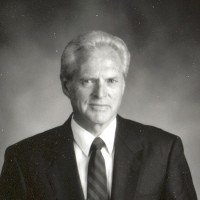
DeVerle P. Harris
AIME Mineral Economics Award in
2000
DeVerle was born at Lovell, Wyoming on 21 January 1931. He received his BS degree in geology from Brigham Young University in 1956 and a masters degree in mineralogy and petrology from the same school in 1958. He received the Sigma Xi award for the outstanding masters thesis at Brigham Young University in 1957. In 1965, he received his PhD in mineral economics from the Pennsylvania State University. Again, his doctoral dissertation, entitled "An Application of Multivariate Statistical Analysis to Mineral Exploration," was outstanding and widely cited by his colleagues. Prior to his PhD program, DeVerle had worked as a structural and photogeologist with Geophoto, Inc. of Denver, Colorado, where for 3 years, he was heavily involved in geological mapping of many regions of North and South America and northern Africa.
DeVerle joined the Research Department of Union Oil Company of California as a research geologist and geostatistician shortly after earning his PhD degree. There, he created a project for the quantitative estimation of offshore Venture Basin petroleum resources. In the following year, The Pennsylvania State University persuaded DeVerle to join the Department of Mineral Economics and conduct research on the mineral-resources of Alaska. There, he served as assistant, associate, and full professor, teaching mineral economics and developing improved methods for mineral resources assessment. In 1974, Dr. Harris became professor of geological engineering, Department of Mining and Geological Engineering, The University of Arizona, where in 1976 he created the MS and PhD program in Mineral Economics and served as its director until January of 1994, when he was appointed Professor of Geosciences.
The influence of DeVerle's scientific work is profound in the fields of geoscience, mineral economics, mineral resources, and statistical applications. Dr. Harris has authored and coauthored four books and about 80 referenced articles and symposium papers. His first book, entitled Mineral Resources Appraisal, published by Oxford in 1984, has become one of the indispensable and standard references for resource analysts, geomathematicians, mineral economists, and other geologists who are interested in quantitative resources estimation. The same book also was translated into Chinese and published in Beijing China. He is recognized as one of the few early geoscientists who dared to apply multivariate analysis to geological problems in the days when computers were new and rarely used. The work in his PhD dissertation represents a benchmark for multivariate geomathematics. DeVerle was the first using multiple discriminant for evaluation of mineral potentials. His famous Mineral Wealth Probability Model represents a well structured blend of geology, economics, and statistics. Although versed in objective methods for mineral-resources evaluation, DeVerle has made significant contributions to the progress of subjective methodologies, including expert systems. In the late 1970s, the interest in the uranium resources had created a strong demand for expert systems as part of potential supply estimation. He and his students created various probability models based on formalization of geologic decisions. All of these developments have been well documented in his publications.
Recently, he and his students proposed and developed a new notion, referred to as "intrinsic sample," which forms a sound geoscientific basis for both subjective and objective mineral resources estimation. This new concept ensures the appropriate linkage between resource models and genetic deposit models. In brief, DeVerle has been widely regarded as the world leader of mineral-resources assessment. The contributions made by DeVerle in the field of mineral economics are equally impressive. He has developed innovative forecasting methods for metal and energy commodities, such as life cycle models of supply, translog intensity of use models, simple and extensive learning curve models for petroleum potential supply. He also has developed and demonstrated analytical methods for the economic optimization of exploration. His filtering model, which describes the relations of deposit grade, tonnage, depth, and economics factors, provides a useful guide for deposit feasibility studies in the mineral industry and decisionmaking in governmental agencies. Not only outstanding in research, DeVerle's achievement in teaching also deserves special credit. He developed the only educational and research program in the United States, or the world, on methods for the quantitative appraisal of mineral and energy resources. He has taught a wide range of graduate courses, covering the fields of mineral-resources estimation, mineral exploration, econometrics, mine investment analysis, mineral economics research, and geostatistics. He has maintained between 20 to 30 graduate students in the Mineral Economics Program on average, and he has supervised a host of PhD and MS students, many of whom are on their way of distinguished careers. In addition to teaching and research, he has been an active consultant to mineral and energy companies, research institutes, governmental agencies or groups, and academic institutions. Moreover, DeVerle has been active in scientific organizations. For example, he serves on the Advisory Board of Nonrenewable Resources, a publication of the IAMG.

